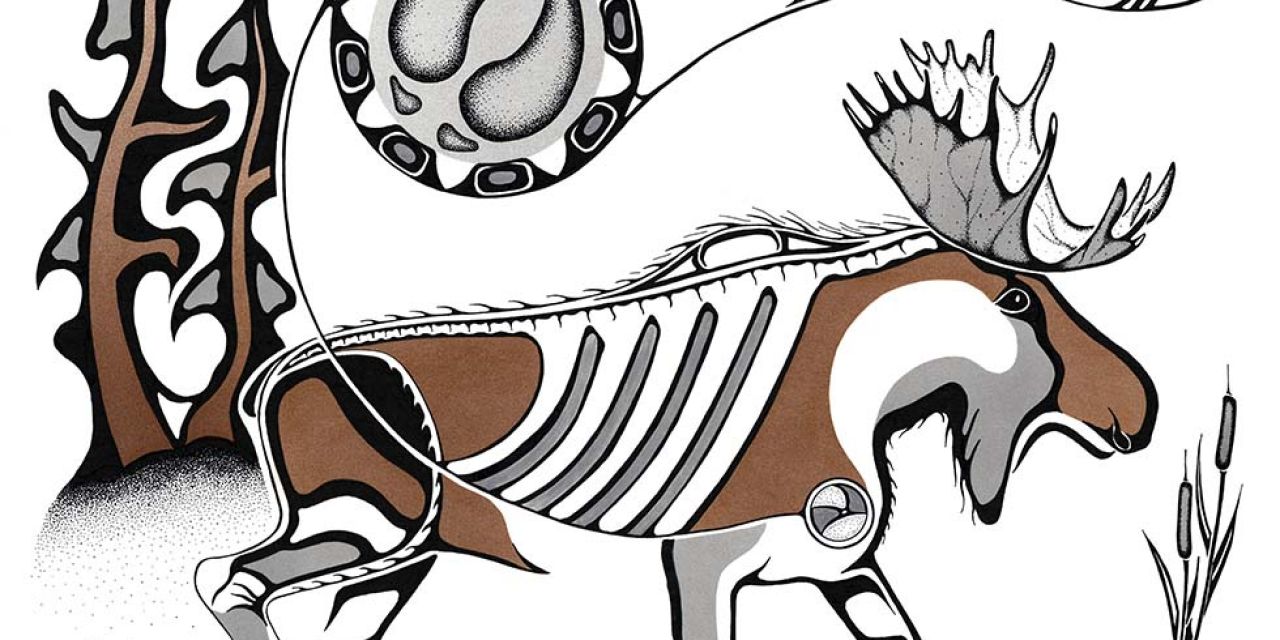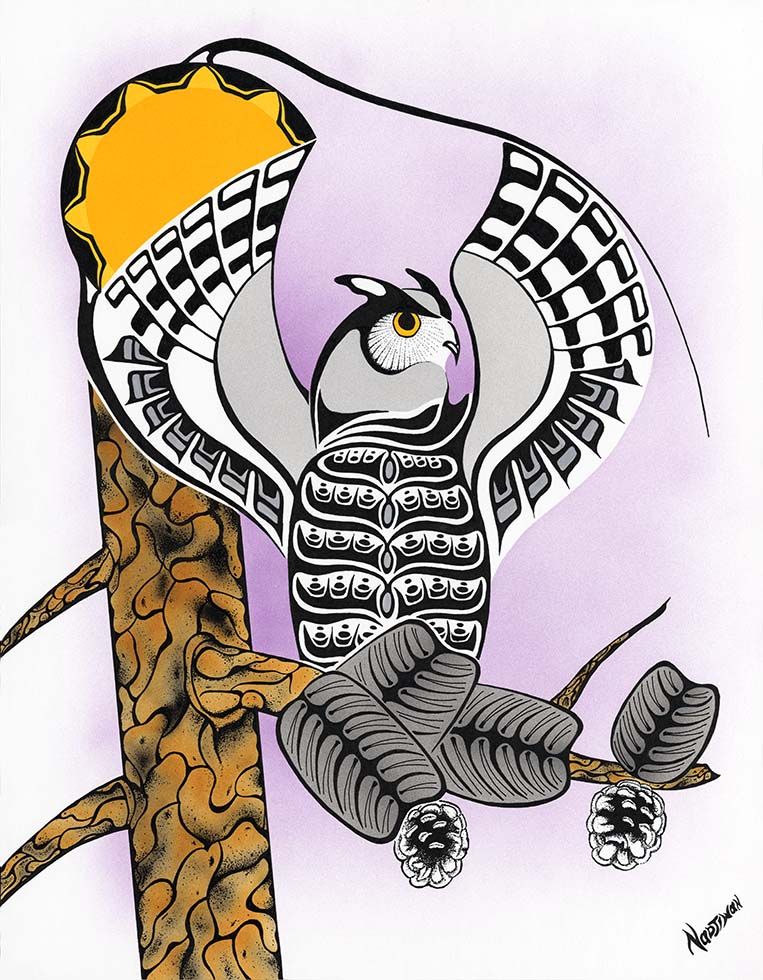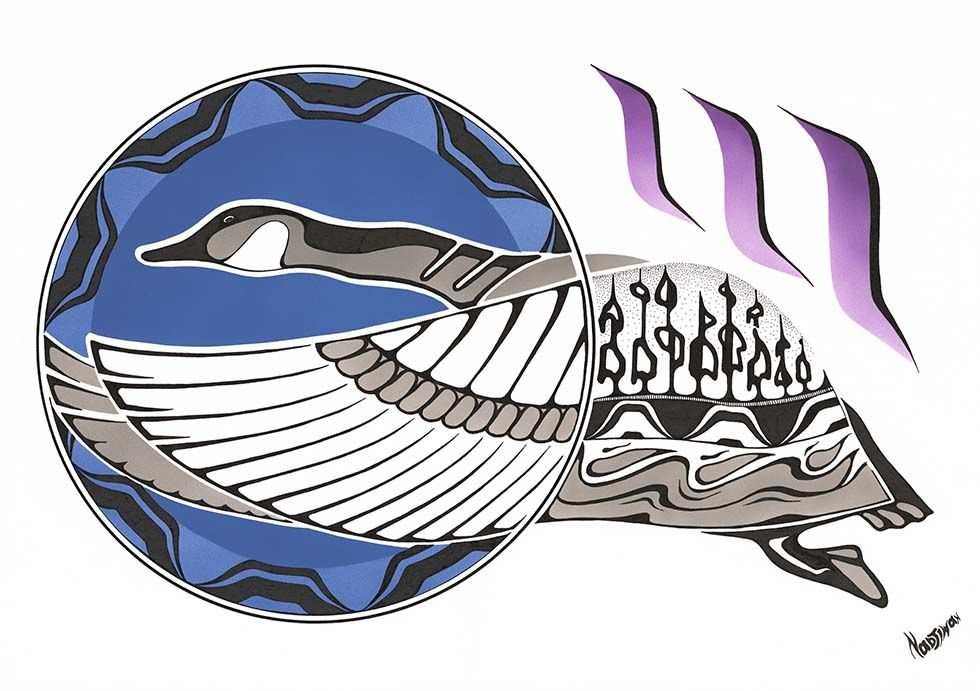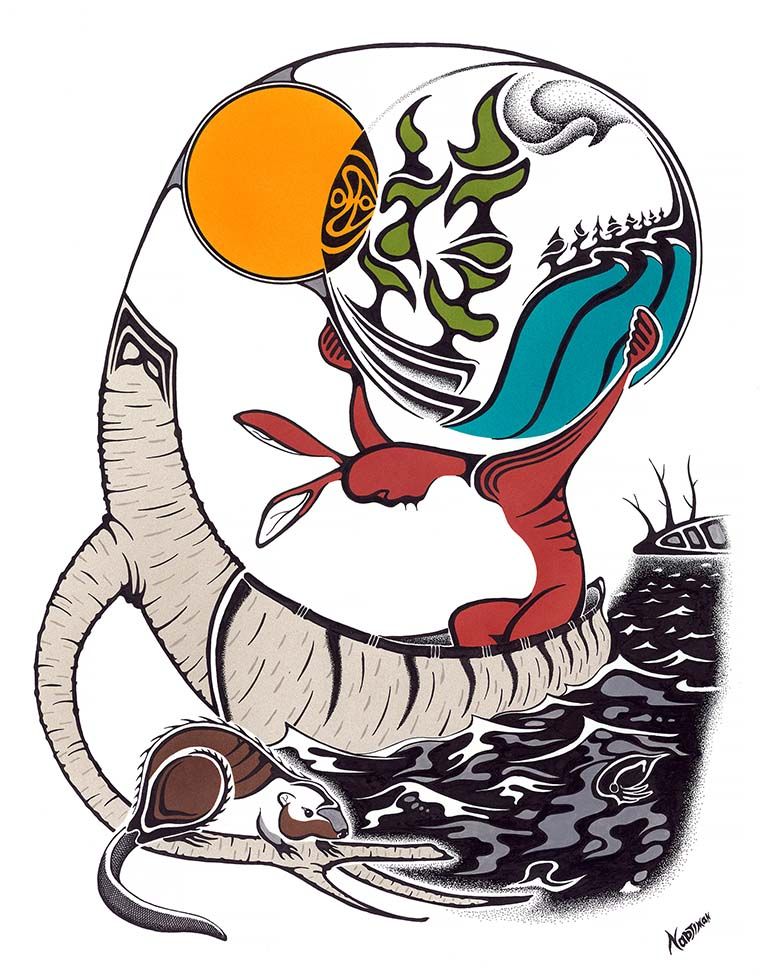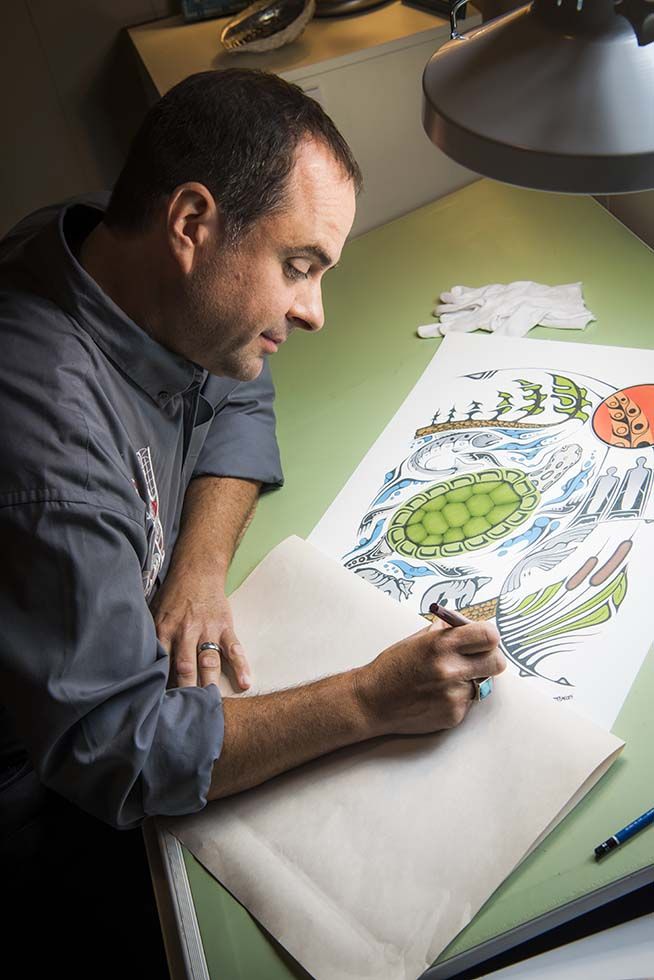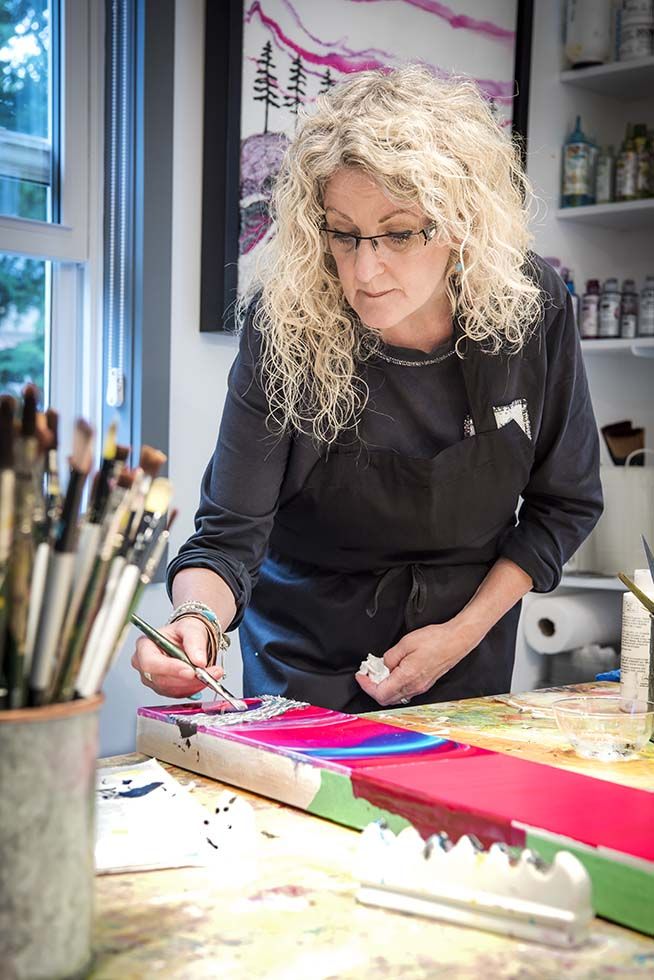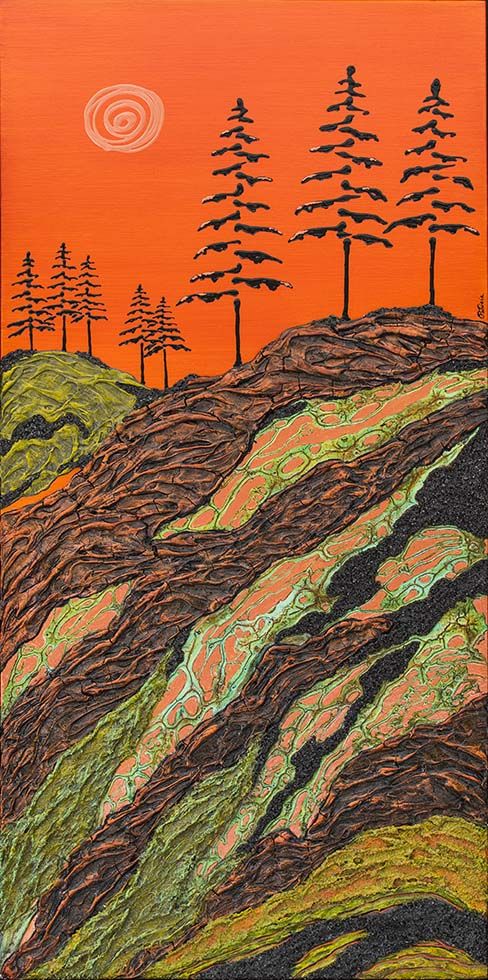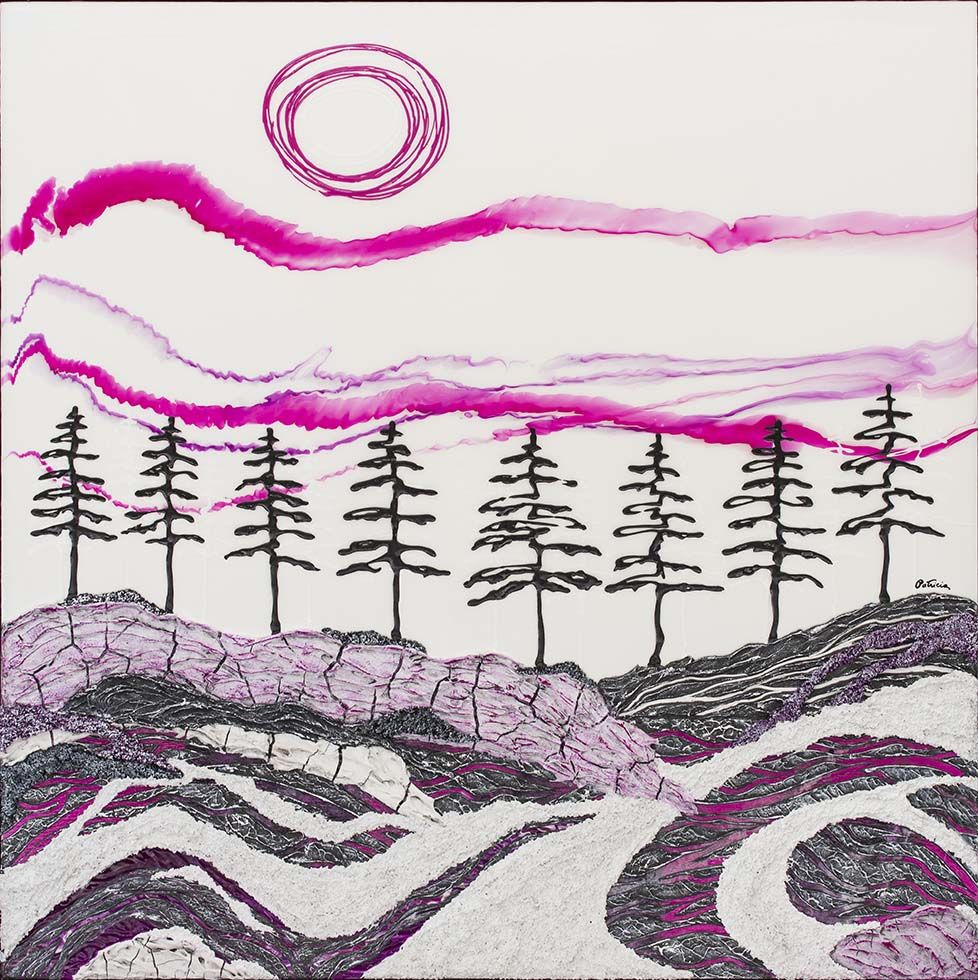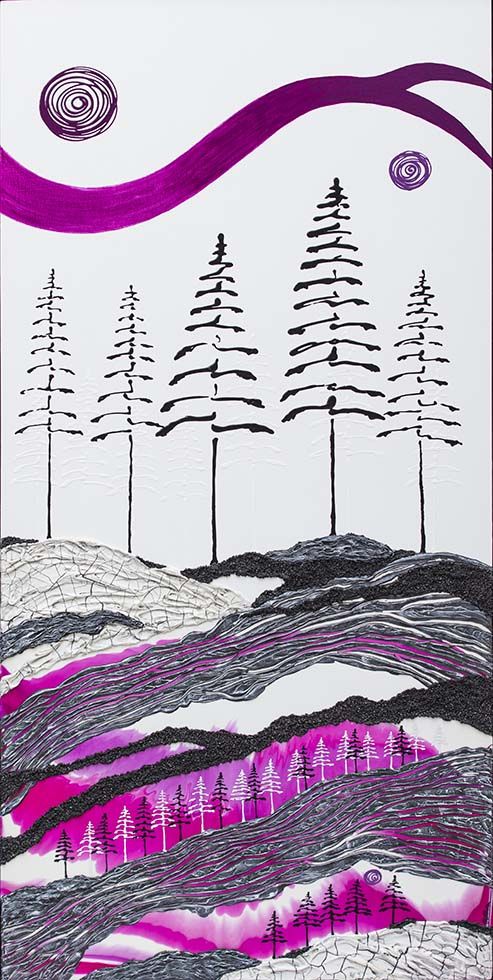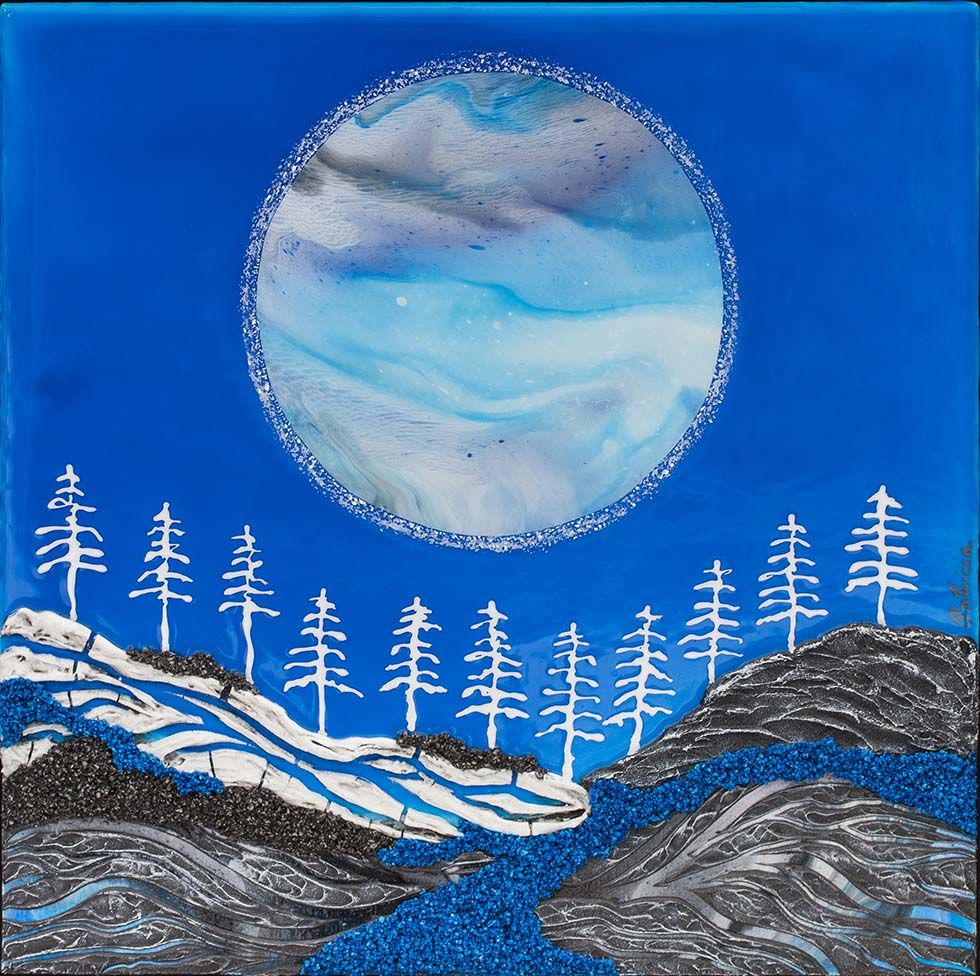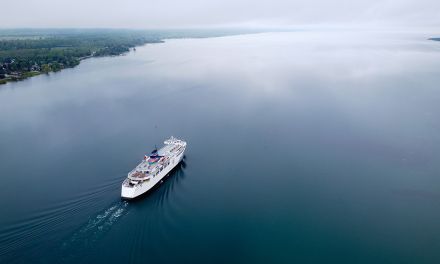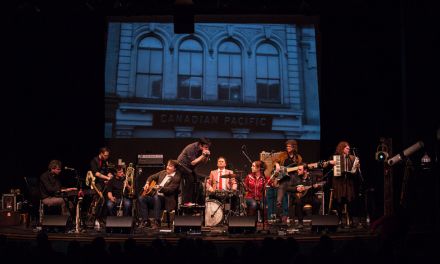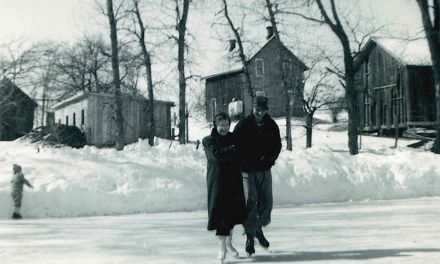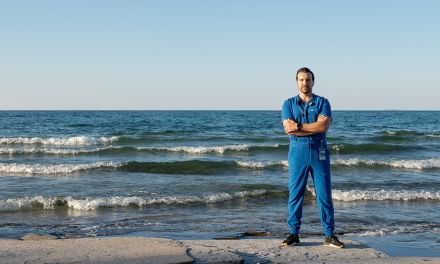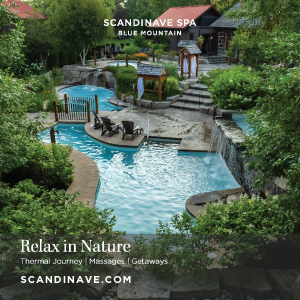Homage To N’Dakiiminaan [Our Land]
Story by Cara Williams Photos by Clay Dolan
Prior to relocating to the Saugeen Peninsula in 2017 (a name he prefers over Bruce Peninsula), most of Mark Nadjiwan’s life had been lived in northern Ontario. “From a relatively early age, I began to intimately experience the wild spaces of the northern Treaty areas that would come to inform and inspire my artwork later in life,” says Mark. These lands include the eastern and northern coasts of Lake Superior country, as well as the Temagami wilderness region of northeastern Ontario. Later in life, Mark spent 12 years as an Indigenous Advisor for a federal agency, which provided further exposure to the many First Nations communities and cultures as well as the vast wild lands that constitute Ontario’s north, including the James and Hudson’s Bay frontiers. “Unfortunately, my previous career as an Indigenous Advisor came to a rather unsavory end in 2018, one that was decidedly unreconciliatory,” says Mark. “So today, it is my art that I use as a vehicle for cross-cultural awareness and healing and I believe with positive outcomes. I am able to draw on my Peoples’ knowledge of the land and those creatures who dwell upon it to render images and accompanying teachings in the form of written ‘stories,’ that are cross-cultural in their relevance and appeal. These stories speak of traditional Indigenous knowledge and culture but in ways that make it accessible to settler-Canadians as well. I like to think of my work as my own contribution, however small, to the work of reconciliation.”
Mark and Patricia met nearly 30 years ago when they happened to sit next to each other in a university philosophy class. “We were each in very different life circumstances at the time and subsequently lost touch,” says Mark. “The Great Mystery being what it is, our paths aligned once again, reconnecting us in 2005. We married in 2008 and our respective art forms have taken on greater and greater priority in our lives.” Today the couple makes their living primarily as visual artists, last year having built and opened Meraki Art Studios, just north of Lion’s Head.
In terms of artistic influence, and given that his chosen medium is pen and ink, Mark was drawn to Woodland Indigenous artists such as Carl Ray and Jackson Beardy, whose styles and often limited colour palettes inspired him. “During my years as an adolescent and young adult, I drew exclusively in black on white with calligraphy pens dipped in India ink. Today these pens have been replaced by technical pens and acrylic inks and I primarily use only a limited number of colours beyond the black and greys.” Mark explains that he has crafted a unique style by combining elements of the Woodland School of Indigenous art developed by the Anishnabek (Ojibway) and Cree, with the design motifs found in Northwest Coast art, such as among the Salish and Haida.
“I work mostly from remembered knowledge of what I know about the places and animals I choose to render,” explains Mark. “That is, remembered from what I have seen and experienced when I’m ‘out there’.” Mark’s originals are created on an acid-free illustration board. Because his work is clean, detailed, and meticulous, it involves a high degree of technicality and often incorporates additional instruments beyond his pen. “When it comes time to apply colour, after my initial black form lines are down, I have to painstakingly create stencils using frisket films and various other masking techniques prior to doing my colour sprays. This is how I achieve the uniformity and gradations of colour. Each stencil can take hours to create and place and that does not include the pre-spray pen work nor the many hours of inking that takes place after colour has been applied. All this happens over a period of several weeks or even months. This leads me to an important point about my process; I often say I am not a ‘production’ artist, producing a copious amount of new work on a steady basis.” Due the immense detail and technicality of his work, Mark produces just a handful of new images a year, which he says allows him to foster a deep connection with his art. “Each piece has its own story in terms of the ‘relationship’ that developed over the course of its creation between I, the ‘creator’ and it, the ‘created’. It’s hard to put into words. But what this also does is create more anticipation among my collectors and carriers, as they always look forward to hearing that new work is coming.”
Mark’s subject matter is broadly based and cannot solely be labeled as inspired by the Peninsula, but he explained, “The Saugeen Peninsula provides an ‘energetic’ inspiration. Firstly, the northern portion where we live has the largest remaining intact wild spaces left in southern Ontario—and wild spaces (and their inhabitants) are my subject matter. Secondly, and perhaps even more importantly though, is the fact that my coming to the Peninsula represents a ‘homecoming’ for me, of sorts. A prior generation of my family left the Neyaashiinigmiing (Cape Croker) community in the late 1950’s and went north. So even though most of my life was spent in the northern Treaty areas, it is the Saugeen Peninsula (Treaty 72 lands) that are my true Indigenous home. I am aware of an ancestral energy and presence here when I am at work in my studio, or walking the forested areas of our own property or the stone beaches of the big bay waters.”
The James Bay Lowlands region of Northern Ontario, where Patricia spent her formative years, remains accessible only by train or plane even today, with the exception of an ice road that is navigable for a few weeks during the coldest winter months. “It was in this land of the Mushkegowuk, that I developed such a close kinship with the natural world,” explains Patricia. “And this kinship continues to inform my artistic expression today. I still find myself seeking out remote areas—what I refer to as ‘wild and sacred spaces’—not only for inspiration but also for a sense of renewal in terms of my creativity as well as the physical, emotional, psychological, and spiritual aspects of my being. There is such a healing power present in nature and it has the ability to transform our lives by putting us in perfect accord with our own essence. Visual art provides a vocabulary if you will, to articulate the musings of the soul. So, when I return to my studio painting is my way of not only processing my many and varied experiences, but also a way to outwardly express the internal experiences that I had while being ‘out there.’ And I do this through the use of colour, texture, and form as well as by exploring various elements of composition and design.”
Patricia’s process includes building layers of paint, gel, glaze, paste, and grounds onto wood panels which creates unique texture and depth with every tier. “I choose to work with acrylics because there is such an array of products that work well together making the creative possibilities endless. I spend a great deal of time experimenting in the studio to see just how far any given product can be pushed and how they will interact with one another.” In her paintings Patricia tends to create small vignettes or “scenes” that equate to landscapes within landscapes. She explained, “What I am really doing is challenging preconceived notions about the true nature of reality through colour and composition. I often work with a bold colour palette such as in my deep purple skies and lime green suns. Science has proven that in the physical world of space and time, there is no such thing as colour. There is only a certain frequency of light that hit the retina, producing an electro-chemical signal that then travels down the nerve fibres to the brain; thus, providing an ‘experience’ of colour. So, if there is in actuality no blue sky in the first place, is it not just as conceivable to depict the sky as purple? I had a wonderful client visit my gallery who said, ‘I just don’t see purple in the sky!’ But the blue sky he ‘sees’ is merely a wonderfully elaborate function of his brain! I paint trees or rocks or whatever else I am depicting in the way I ‘feel’ them, not the way I ‘see’ them. There is a real sense of freedom in that for me as an artist—no rules, just pure expression. I believe that this brings a certain ‘aliveness’ to my work and that is what really resonates with my clients and evokes an emotional response in them. Ultimately, I have taken my cues from nature. When the sun rises in the morning it does so ‘boldly.’ During a storm the sky thunders and rain pours down boldly. Unapologetically one might say. And this is the way that I paint.”
Meraki Art Studios, located just north of Lion’s Head on the beautiful Saugeen (Bruce) Peninsula, will remain open throughout the fall and by appointment during the winter months. Here, visitors will find a range of products including originals by both Patricia and Mark (when available). Mark also offers limited editions, smaller matted and/or framed reproductions, and art cards. “On account of the limited amount of new work from me each year I often don’t have originals available for very long,” explains Mark. “But what I like about my work is that it is easily reproduced into other formats and for many people, affording original artwork is beyond their financial means. Thus, items like limited editions can become the entry-point for people into the world of art acquisition and collection. The ‘accessibility’ of my work is very important to me so it pleases me that the range of products and prices means this small ‘reconciliatory’ enterprise that is my art can reach far and wide, across all cultures.”
Mark’s work can be viewed in Ontario venues such as the Ahnisnabae Art Gallery in Thunder Bay, the Bittersweet Gallery in Burnstown, and Cornerstone Canadian Art and Craft in Kingston. Mark’s piece “For Seven Generations,” garnered nationwide attention and led to an invitation for Mark to be the Indigenous member of a select national team which aims to make the Canada Jay (Whiskyjack) the designated national bird of Canada. Patricia has exhibited her work in both Canada and the United States and her work can be found in select shows and exhibitions across Ontario. For more information visit blacksprucestudio.com and threetreesart.com
Three Trees Art / Black Spruce Studio / Meraki Art Studios & Gallery
240 East Road, Lion’s Head

